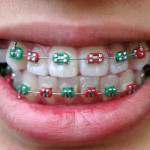
To produce alignment without extraction. It has been suggested that passive self-ligating brackets can introduce specific, uniquely stable arch dimensional changes. The aim of this trial was to quantify maxillary arch dimensional changes and maxillary incisor and molar inclination changes during orthodontic alignment by directly comparing a passive self-ligating bracket, an active self-ligating system and a conventional bracket system.
96 Patients with maxillary second molars erupted and maxillary arch crowding less than 6 mm amenable to non-extraction treatment in the maxillary arch were block randomised in to one of three groups. Alginate impressions of the maxillary arch were taken before treatment and at the end of alignment, a minimum of 34 weeks after appliance placement. Outcome assessment was blinded. The main outcome measures were changes in maxillary intercanine, interpremolar, and intermolar dimensions, and molar and incisor inclination changes. Data were analyzed on a per-protocol basis, since losses to follow-up were minimal.
- Complete data were obtained from 87 participants.
- Intercanine dimensions increased in all 3 groups. A slightly greater increase was seen in the passive self-ligating group but differences did not reach statistical significance.
- Bracket type had no significant effect on any of the transverse dimensional changes.
- No difference in molar inclination was found between passive self-ligation and conventional brackets (0.670; 95% CI, -2.24, 3.58; P= 0.65) or active self-ligation (0.910; 95% CI, -1.95, 3.78; P =0.53).
- Similarly, incisor inclination changes could not be differentiated from those developing with either conventional system (0.440; 95% CI, -1.93, 2.8; P = 0.71) or In-Ovation C (-0.220; 95% CI, -2.58, 2.14; P = 0.85).
- No harms were encountered.
The authors concluded
No difference in the arch dimensional or inclination changes during alignment can be expected between conventional brackets and either active or passive self-ligation.
Comment
The authors highlight in the discussion that the same wire sequence was used with all three bracket systems which allows an unbiased assessment of the ligation mode any changes to arch dimensions.
Links
Fleming PS, Lee RT, Marinho V, Johal A. Comparison of maxillary arch dimensional changes with passive and active self-ligation and conventional brackets in the permanent dentition: A multicenter, randomized controlled trial. Am J Orthod Dentofacial Orthop. 2013 Aug;144(2):185-93. doi: 10.1016/j.ajodo.2013.03.012. PubMed PMID: 23910199.

#CochraneEvidence blogged by @TheDentalElf Oral care that reduces ventilator associated pneumonia http://t.co/iV22VVCbGS @CochraneOHG
RT@UKCochraneCentr #CochraneEvidence blogged by @TheDentalElf Oral care that reduces ventilator associated pneumonia http://t.co/CD4SIm1iD4